�
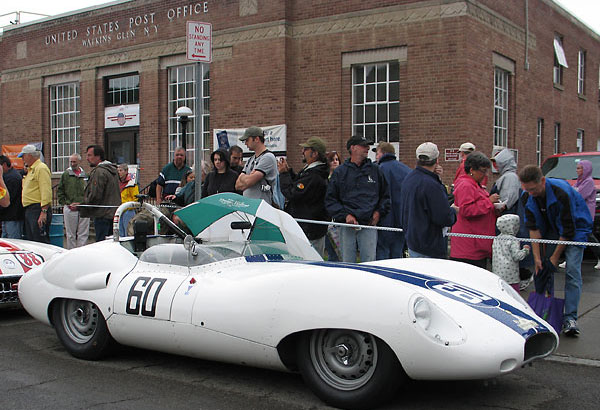
�
Syd Silverman's Costin-bodied Lister Jaguar Race Car
� Owner: Syd Silverman� Model: 1959 Lister (Costin)
� Engine: Jaguar 3.8L
� Restored and race prepared by:
� The Vintage Connection, Oklahoma City�
�
The Lister Jaguar Story
��
Jaguar was a leading player in early 1950's sports car racing. Among countless �
victories, Jaguars won the 24 Hours of LeMans three times in five years. The first �
two LeMans victories came with specially prepared versions of the swoopy XK120, �
but changing times were pushing entrants toward more specialized designs. Jaguar �
answered with their "D-Type", and won LeMans in 1955 after the Mercedes team was �
involved in a horrific crash. It wasn't a celebrated victory: everyone was shocked �
because 84 spectators had died in the Mercedes accident. The racing business �
changed immediately.�
�
Besides building race cars for their own team, Jaguar had made a business of �
constructing racecars for private drivers. After the LeMans tragedy, this business �
was struggling, and it would soon suffer a near fatal blow. A fire swept through the �
Jaguar works, destroying much of their inventory and quite a lot of the means of �
production. Jaguar would of course recover, but for several years after the fire �
they needed an outside chassis builder to supply loyal customers who wanted new �
Jaguar-powered race cars. Jaguar selected George Lister and Sons, a well established �
light-engineering firm in Cambridge. One of the sons, Brian Lister, was a talented �
engineer who had been dabbling with race car design. �
�
Lister Jaguars were developed by Brian Lister with the support of Jaguar, and built �
with production resources of the Lister family business. Jaguar provided competition �
engines, and referred key customers such the British Petroleum race team and also �
Briggs Cunningham in the United States. �
�
Lister Jaguars were made in two distinctly different body styles. Seventeen of�
the original "knobbly" style were built and shipped, but they didn't seem streamlined �
enough, so Lister hired Frank Costin to design a replacement skin. Costin had learned�
aerodynamics at The de Havilland Aircraft Company and had transferred his skills to �
working with Colin Chapman on the Vanwall Grand Prix car and on the Lotus Mark 8. �
The body Frank Costin designed for Lister may have been more streamlined, but it also �
presented a larger cross-section to the wind. Although accurate measurements of the two �
body shapes aren't available to us, Costin himself ultimately declared the new body a �
technical failure. Its improved coefficient of drag couldn't offset its larger frontal�
area - but this wasn't immediately realized by customers. Eleven Costin-bodied Listers �
were built.�
�
Other publications focus on biographical and lifestyle stories. We'll just briefly �
summarize that Brian Lister soon grew weary of racing, prompted by the deaths of two �
drivers he was especially attached to: Archie Scott Brown and Ivor Bueb.�
He retired from the sport and focused on the family business, and only occasionally �
undertook racing related projects in later life. The Lister family name has been �
licensed to a new "Lister Cars Ltd." since 1986, and they've offered a a variety of �
Jaguar and Chevrolet based performance cars. The original George Lister and Sons is �
still going strong, however, providing custom capital equipment to industry. �
�
�

�
The Lister twin-tube frame's main members are 3" diameter, fourteen gauge, seamless drawn, mild steel tubing.
�
Essentially two dimensional and with very little triangulation, this is not a "space frame" design.¹
�
Chassis No. BHL-123 / Engine No. LC1299-8
��
The Cunningham team was already racing Jaguar D-Types when Lister Jaguars first�
became available. Eager to switch to the newest technology, Cunningham took delivery �
of the first two knobbly Lister Jaguars. Driver Walt Hansgen won the 1958 SCCA �
C-Modified Championship with one of them. For 1959, Cunningham was ready to try �
the new Costin-bodied version.�
�
BHL-122 and BHL-123 were the first two Costin-bodied Lister Jaguars built.�
Briggs Cunningham received BHL 123 in time for the inaugural 12 Hours of Sebring�
race in March 1959, where it was co-driven by Sterling Moss and Ivor Bueb. "Ivor �
the driver" had won LeMans for Jaguar in 1955. He had also won LeMans in 1957, �
driving a modified Jaguar D-Type for the Ecurie Ecosse team. During the race, �
Moss was in third place when he pulled in for a scheduled refueling stop. �
Impatient to rejoin the action, Moss left the pits before the tank was full and �
later he ran dry on the course. Moss would have been permitted to walk back to the �
pits for a fuel can. He was disqualified because he hitched a ride back;�
it was against the rules to accept outside assistance. �
�
�
Enjoying this article? www.BritishRaceCar.com is partially funded through generous support from readers like you!
�
To contribute to our operating budget, please click here and follow the instructions.
�
(Suggested contribution is twenty bucks per year. Feel free to give more!)�
�
BHL-123 was subsequently raced with great success by the Cunningham team. In a �
dozen races that year, Walt Hansgen scored four victories (at V.I.R., Cumberland �
Maryland, Bridgehampton, and Watkins Glen) to win the 1959 SCCA C-Modified �
National Championship. BHL-123 was also driven that year by Briggs Cunningham �
himself, who placed third at Thompson Raceway. At the end of the racing season, �
Cunningham sold BHL-123.�
�
Various people have owned and raced BHL-123 in subsequent years. Syd Silverman �
purchased it in 2000, and the car has been driven in many vintage races by �
his son Michael. BHL-123 sold at Gooding & Company's 2010 Scottsdale Auction�
on January 22. It brought a new record price for Lister sports cars: $1,100,000. �
The buyer is reportedly British, and has arranged for shipment of BHL-123 back �
to England. �
�
 �
�
�
�
Features and Specifications
�| Engine: | �Jaguar 3.8L DOHC six cylinder engine.�
~300bhp at 6200rpm.�
Triple Weber 45DCOE carburetors.�
Pipercross foam trumpet socks (i.e. air filters).�
Mallory dual points distributor and Lucas Sport coil.�
MSD6AL capacitive discharge ignition system.�
Accel Hi Temp SuperStock Spiral Core 8mm spark plug wires.�
Stock Car Products four-stage oil pump (for a dry sump lubrication system.)�
Mocal OT2 oil cooler thermostat.�
WIX oil filter, remotely mounted. | �
| Cooling: | �custom replacement radiator by Northhampton Autorads.�
Electric fan. | �
| Exhaust: | �custom fabricated, ceramic coated, dual 3-into-1 headers.�
Dual exhaust. | �
| Transmission: | �Jaguar D-Type 4-Speed manual transmission with close ratio gears �
(2.14:1, 1.63:1, 1.27:1, and 1:1). � Triple plate racing clutch and low mass flywheel | �
| Rear End: | �Salisbury differential with limited slip differential and 3.73:1 gears. | �
| Front Susp.: | �dual wishbone front suspension with rack and pinion steering. �
KONI double-adjustable coilover shock absorbers with Hyperco springs. �
Custom-fitted Schroeder Racing Products adjustable anti-sway bar. | �
| Rear Susp.: | �DeDion suspension with coil-over shock absorbers and sliding block lateral location. | �
| Brakes: | �(master) dual Girling master cylinders with bias bar, and remote mounted reservoirs. Wilwood residual pressure valves. � (front) Girling calipers. Solid rotors. � (rear) inboard Dunlop disc brakes. | �
| Wheels/Tires: | �Dunlop steel wheels (D-Type pattern), with 6.00L16 Dunlop Racing tires. | �
| Electrical: | �Delco Remy alternator. | �
| Instruments: | �(left to right) Smiths coolant temperature gauge (30-110C),�
Smiths mechanical tachometer (500-8000rpm),�
Smiths oil pressure gauge (0-100psi), �
Smiths oil temperature gauge (40-140C),�
XT Racing Ultra Lap digital lap timer. | �
| Fuel System: | �racing fuel cell and dual Facet fuel pumps. | �
| Safety Eqpmt: | �SPA Design AFFF fire suppression system.�
Simpson five-point cam-lok harness.�
Schroeder Racing Products steering wheel with quick-release steering wheel hub.�
Longacre roll hoop pads | �
| Weight: | �~1700 pounds. | �
| Racing Class: | �SCCA C-Modified (circa 1959). | �
Engine Installation
��
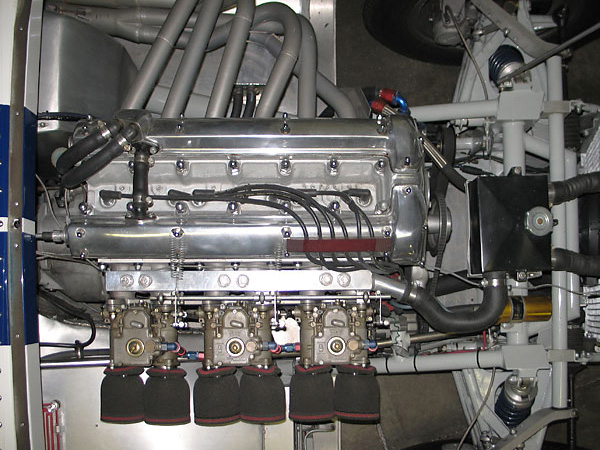
�
Jaguar D-Type 3.8L DOHC six cylinder engine.
�
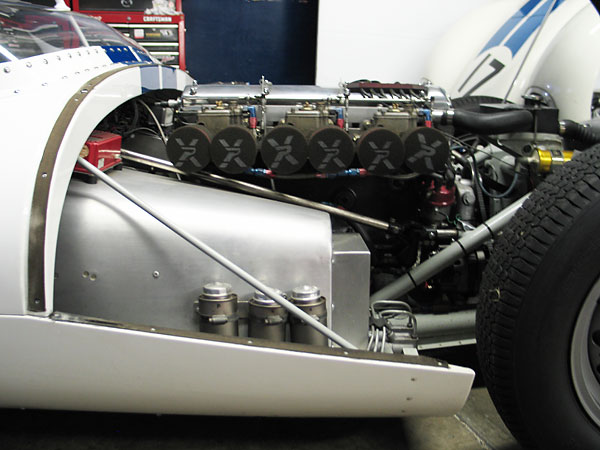
�
Triple Weber 45DCOE carburetors.
�
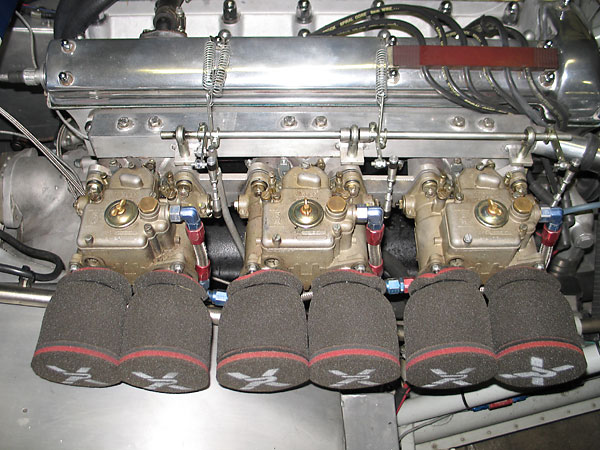
�
Pipercross foam trumpet socks (i.e. air filters).
�
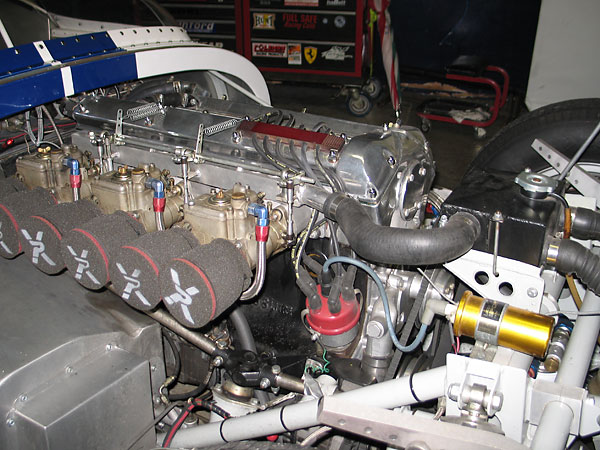
�
Mallory dual points distributor and Lucas Sport coil.
�
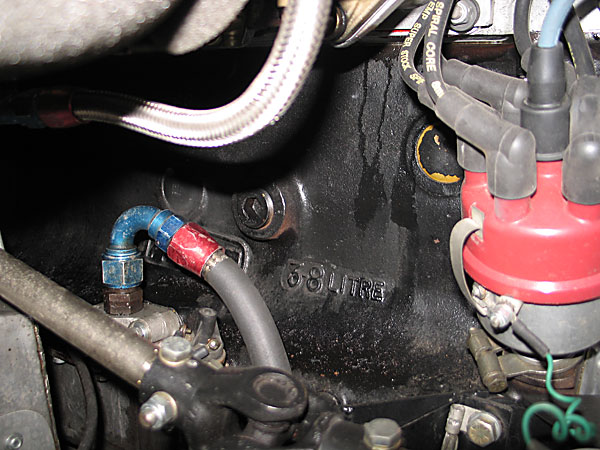
�
The Jaguar 3.8 litre inline six is one of history's great engines, but it's not lightweight by any standard.
�
Many Lister buyers, notably including Jim Hall and Carroll Shelby, decided they'd rather have V8's and
�
Lister was happy to deliver the chassis without engine. With a small block Chevy V8, the Lister would
�
have more power with no weight penalty, but typically it shifted the cars into different racing classes.
�

�
Note the red Wilwood residual pressure valve to the right of the master cylinders.
�
A modern alternator can also be spotted just inboard of the frame tube.
�
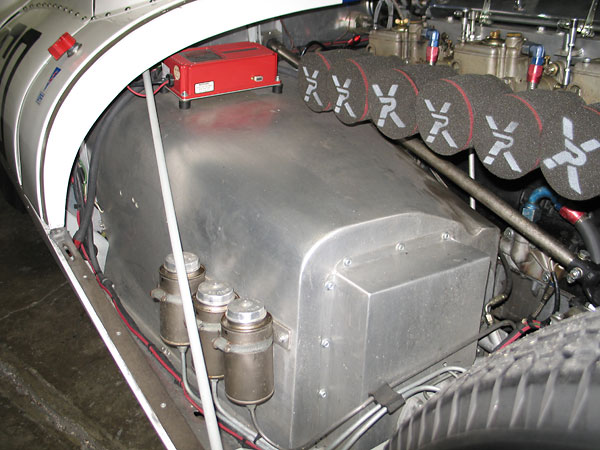
�
The battery cable and fuel line are routed forward along the righthand edge of the body.
�

�
Battery disconnect switch. (The battery is mounted at the extreme rear corner of the car.)
�

�
MSD6AL capacitive discharge ignition system, with 6400rpm rev limiter chip installed.
�

�
The dashboard and the firewall are one and the same.
�
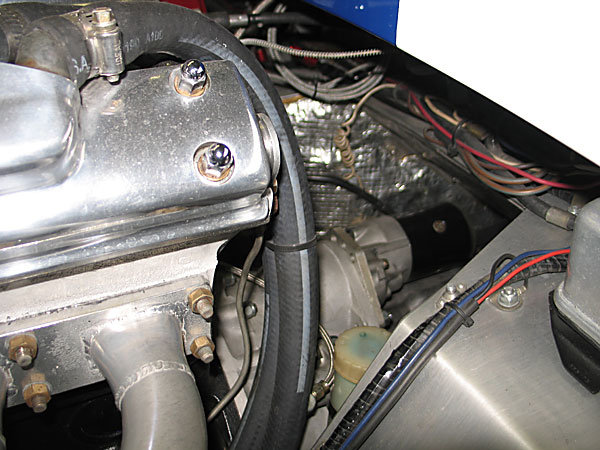
�
The starter motor is mounted from the rear because the flywheel and ring gear are small in diameter.
�
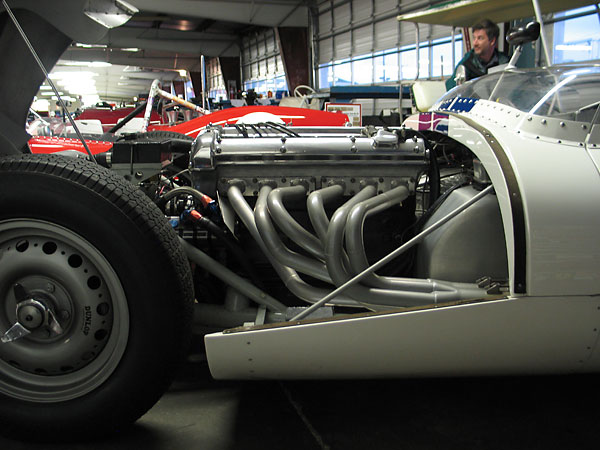
�
Custom fabricated, ceramic coated, dual 3-into-1 headers.
�
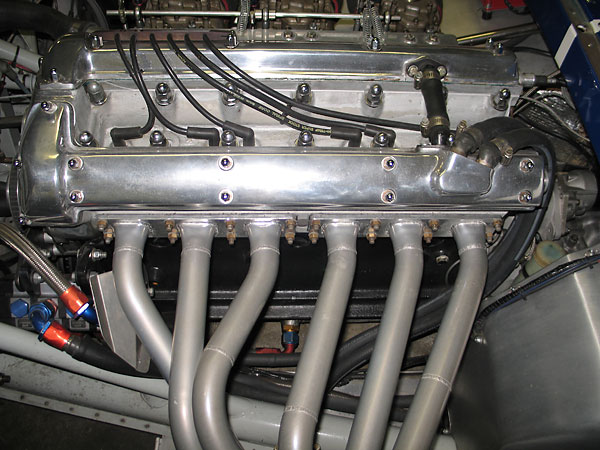
�
Accel Hi Temp SuperStock Spiral Core 8mm spark plug wires.
�
Upper right: the tachometer cable is driven by the righthand camshaft
�
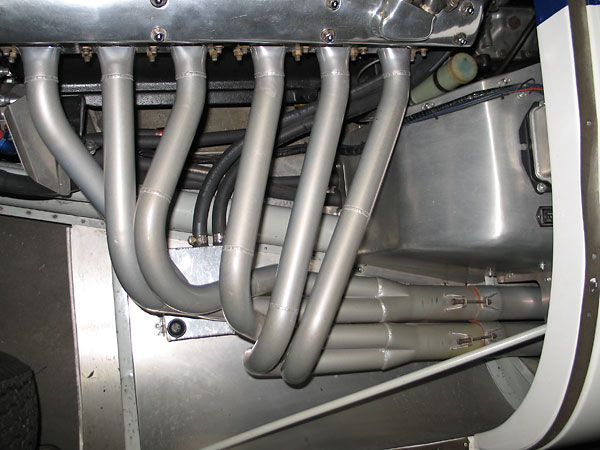
�
A custom aluminum crankcase breather tank is tucked underneath the headers.
�
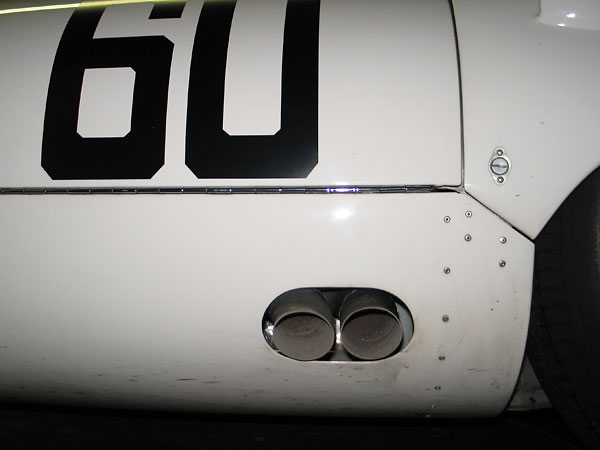
�
The exhaust exits below the passenger-side door.
�
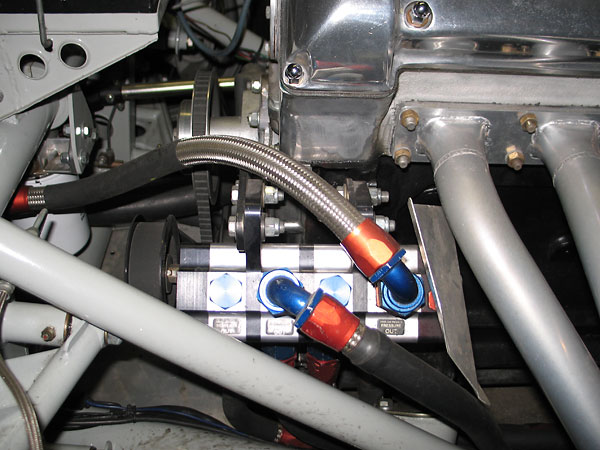
�
Stock Car Products four-stage oil pump (for a dry sump lubrication system.)
�
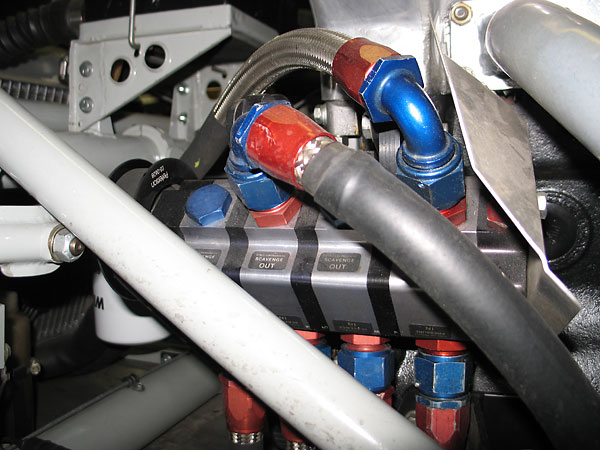
�
Peterson Fluid Systems' Gilmer-drive pulley system.
�
Please support the sponsoring companies who make www.BritishRaceCar.com possible, including:
� �
 �
�
�
�
�
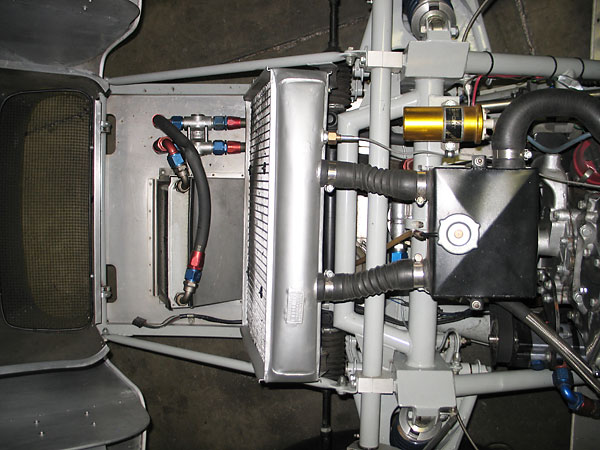
�
Overview of the cooling system.
�

�
Fabricated steel header tank with pressure cap located at the high point in the cooling system.
�
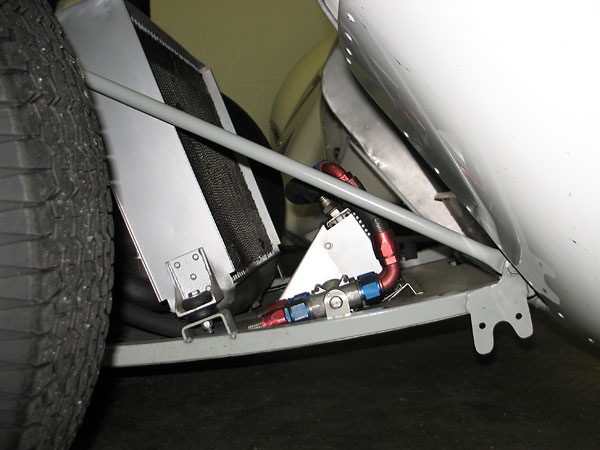
�
Air that goes through the oil cooler is ducted down, instead of through the radiator.
�

�
Foreground: Mocal model OT2 oil cooler thermostat.
�

�
Duct tape has been used to block part of the oil cooler, to help the engine run warmer. Black plastic
�
buttons on the radiator core are attachment hardware for an electric fan (mounted on the other side).
�
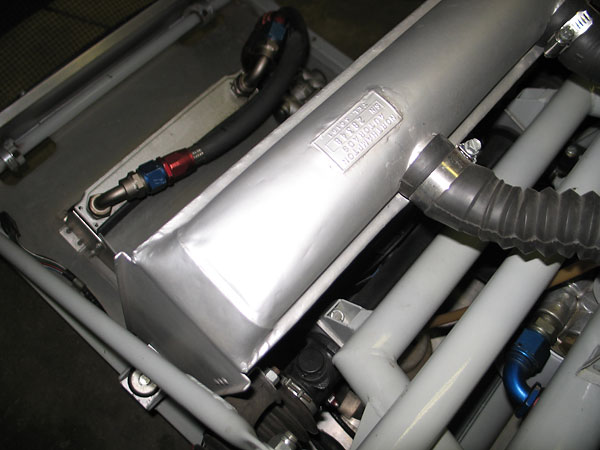
�
Northhampton Autorads radiator, serial number 28348.
�
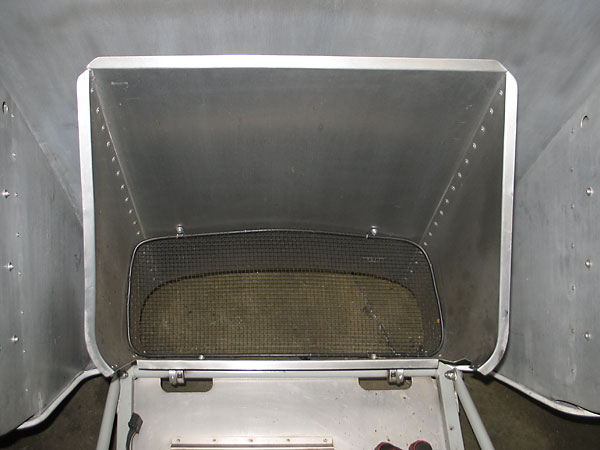
�
Nifty ductwork assures that cooling airflow doesn't bypass the radiator core.
�
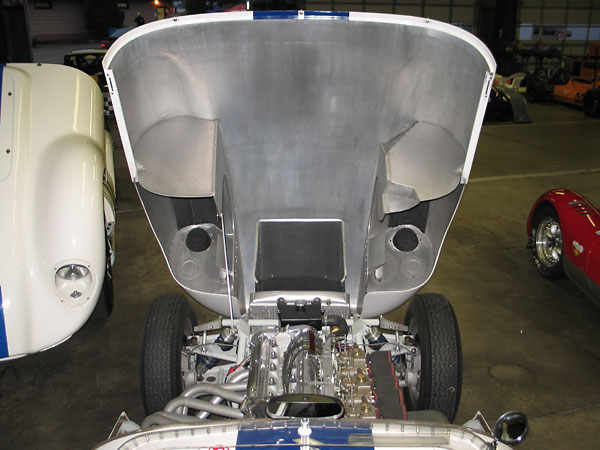
�
The aluminum front clip tilts forward, like a Jaguar E-type. Looks like brand new, doesn't it!
�
�
Front Suspension
��
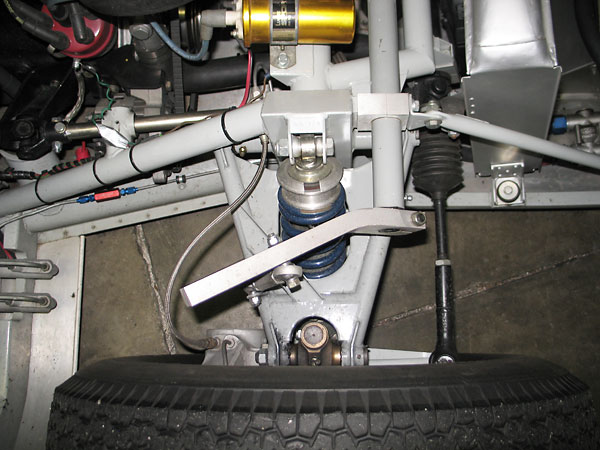
�
Custom-fitted Schroeder Racing Products adjustable anti-sway bar.
�
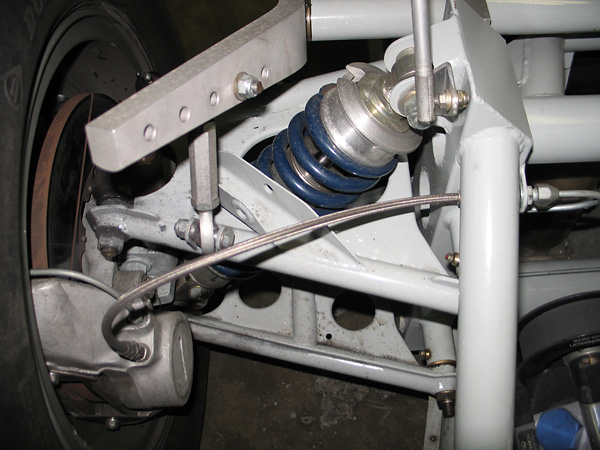
�
The sway bar itself is steel, and it's straight with splined ends. Aluminum levers clamp to it.
�

�
These wishbones are an upgrade over the original design. Lister went through a series of detail changes
�
for the front suspension design. Originally, he used Morris uprights but found they weren't strong enough.
�
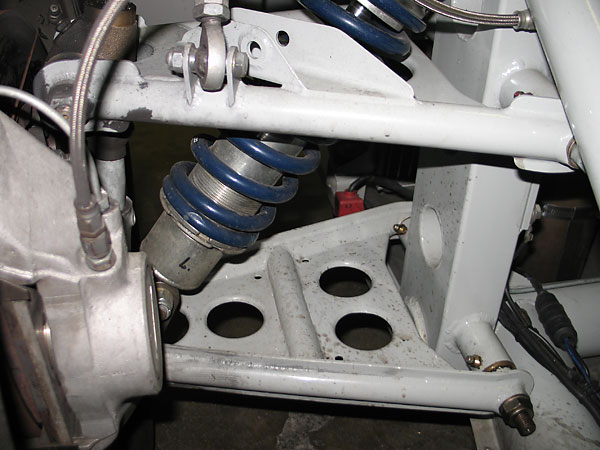
�
KONI double-adjustable coilover shock absorbers with Hyperco springs.
�

�
The black knob at the bottom of the KONI shock absorber is for adjusting how it dampens in compression
�
("bump"). Extension ("rebound") dampening is adjusted by inserting a pin into a slot at the top of the
�
shock, and sweeping the internal mechanism from left to right (for a firmer setting) or vice versa.
�
�
Enjoying this article? www.BritishRaceCar.com is partially funded through generous support from readers like you!
�
To contribute to our operating budget, please click here and follow the instructions.
�
(Suggested contribution is twenty bucks per year. Feel free to give more!)�
Rear Suspension
��
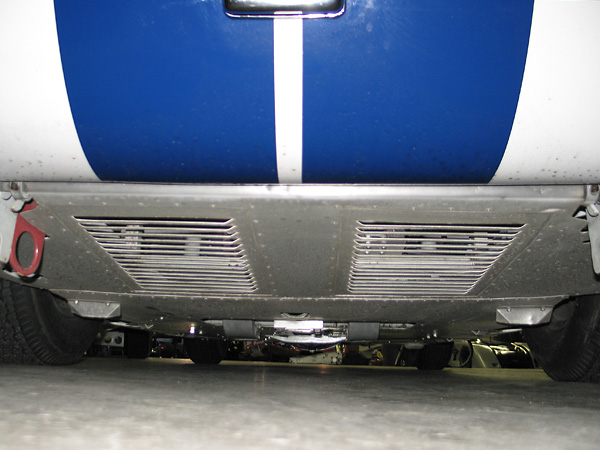
�
The Lister features a DeDion-type rear suspension with an unusual "sliding block" lateral location device.
�
Elsewhere on this site, you can see more common methods of lateral location: Watts linkage, Panhard
�
bar, mounting the DeDion tube on leaf springs... Body panels and belly pans kept us from getting good
�
photos of the Lister rear suspension, so instead we'll provide the following sketch and description.
�

�
The DeDion tube and its sliding block (i.e. basically a pin with a bushing mounted on it) are shown in blue.
�
The differential housing and the vertically slotted chassis member that locates the pin are shown in yellow.
�
As the illustration shows, the height of the pin on the DeDion tube defines the roll center characteristic of
�
the rear suspension. As also shown, Lister mounted the differential off center to provide more room for the
�
driver, at the expense of somewhat asymmetrical handling behaviour. Incidentally, the sliding block idea
�
wasn't invented by Lister: it had been used by Mercedes and BRM on Grand Prix cars. Why haven't sliding
�
blocks become more common? They can be susceptible to wear and "stiction". On the other hand, a major
�
advantage of Panhard rods and Watts Linkages is they facilitate moving the roll center closer to the ground.
�

�
Lister's DeDion rear suspension utilized pairs of equal length trailing links, arranged in parallel.
�
Original links had Heim joints at the front end and rubber bushes at the rear. These replacements
�
have evidently been fitted with opposite (RH/LH) threaded Heim joints for more convenient alignment.
�
�
Interior
��

�
Schroeder Racing Products steering wheel, mounted on a quick-release steering wheel hub.
�
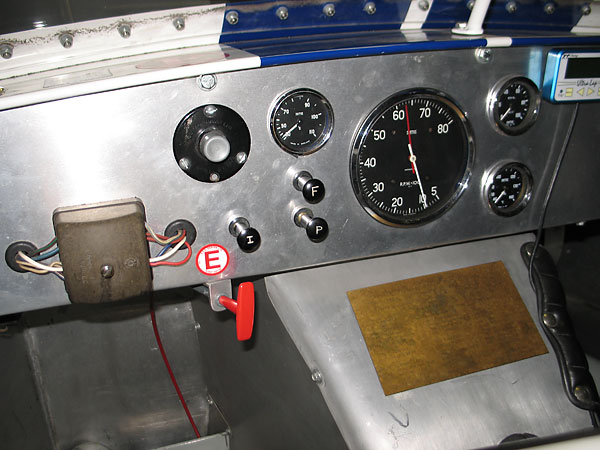
�
(left to right) Smiths coolant temperature gauge (30-110C), mechanical tachometer (500-8000rpm),
�
oil pressure gauge (0-100psi), and oil temperature gauge (40-140C). XT Racing Ultra Lap timer.
�
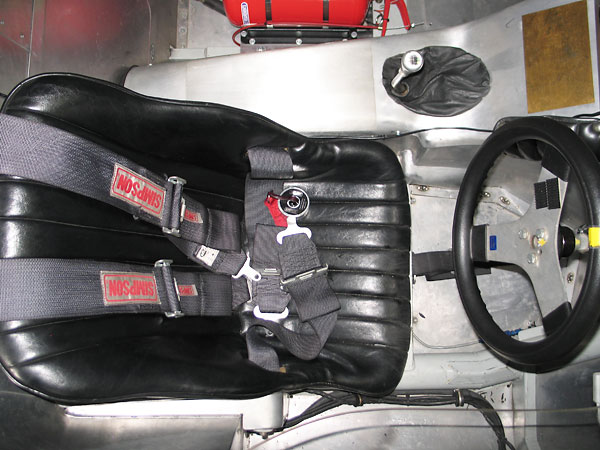
�
Simpson five-point cam-lok harness.
�

�
This roll hoop was added in the early 1980's. Note also the peculiar aluminum ductwork behind where a
�
passenger seat would've gone. Frank Costin came up with an elaborate scheme for smoothing airflow.
�
Instead of installing a rigid tonneau cover, he reasoned that a loose vinyl cover could be designed to puff
�
up if supplied pressurized air from underneath. At speed, the puffed-up cover spanned from the rim of
�
the windscreen back to the rear edge of the cabin. This duct allows surplus air to exit into the luggage
�
area where it would help cool the brakes.
�
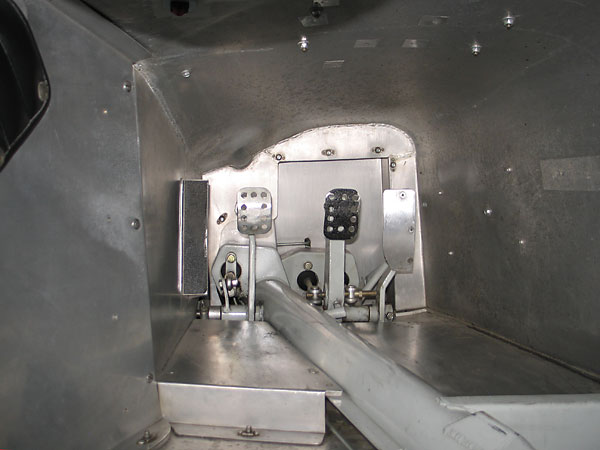
�
The pedals and master cylinders are mounted on brackets off the frame, not bodywork. The footbox
�
has an uneven floor; the driver's feet actually straddle one of the main longitudinal frame tubes.
�

�
SPA Design AFFF (foam) centralized fire suppression system.
�
�
Exterior
��
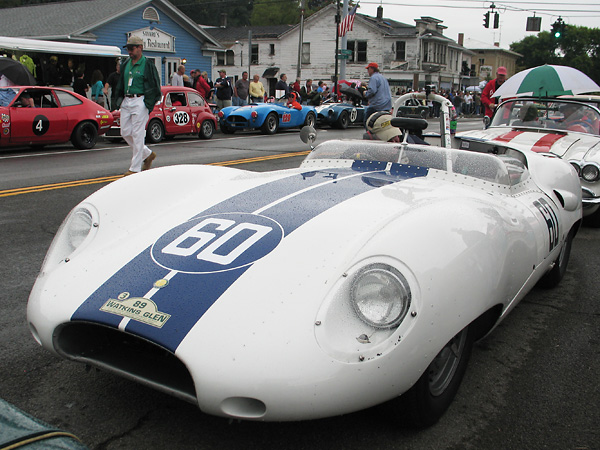
�
Lister sourced their bodies from Williams & Pritchard, of London. This particular Costin-Lister (BHL123)
�
has an all aluminum body. Reportedly, lighter weight Elektron (magnesium alloy) bodies were alternatively
�
available and were ordered by some of Costin's customers.
�
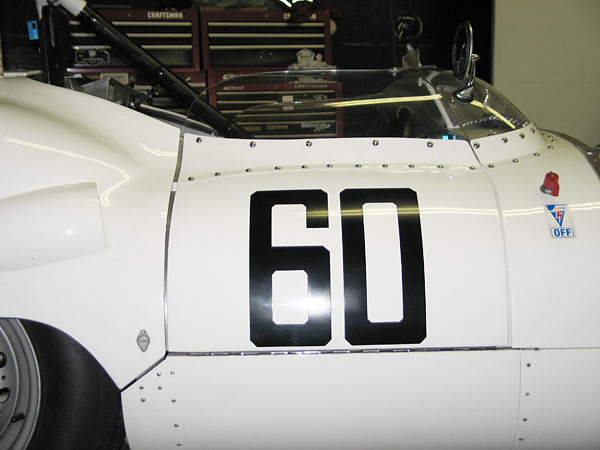
�
Wrap-around Perspex (acrylic) windscreens became a common feature of sports racing cars of this era.
�
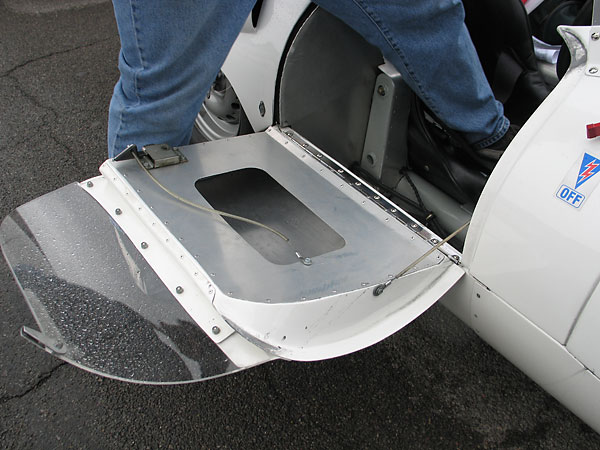
�
The open door exposes one of the two rear suspension attachment brackets, cantilevered off the frame.
�
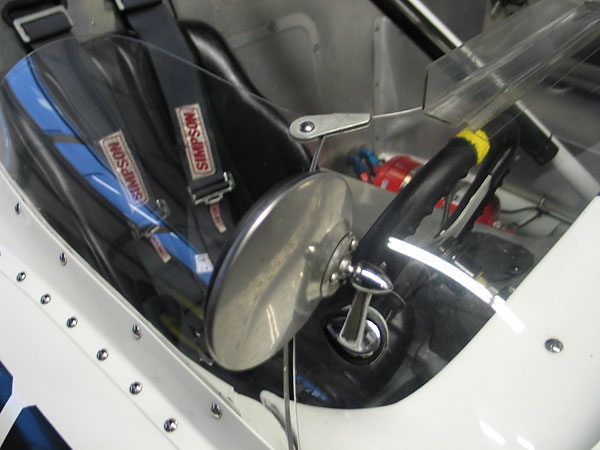
�
The easiest way to service the differential and rear suspension is through access panels behind the seat.
�
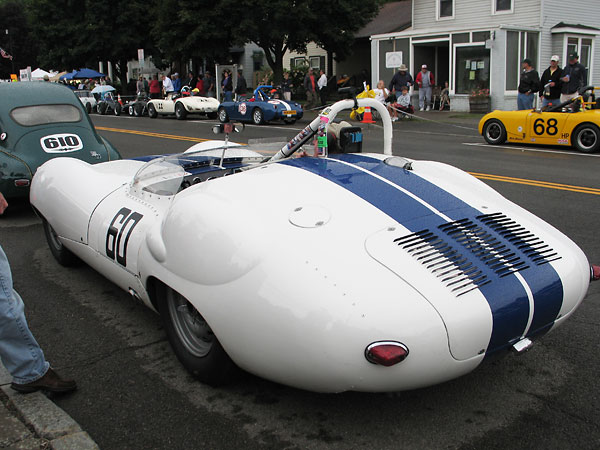
�
Four Dzus fasteners facilitate removal of the boot lid, to access the spare tires and luggage compartment.
�
The existance and size of which were specified by LeMans rules. Alternatively though, the larger rear body
�
panel can be removed for servicing the fuel cell, fuel pumps, battery, and engine oil reservoir.
�
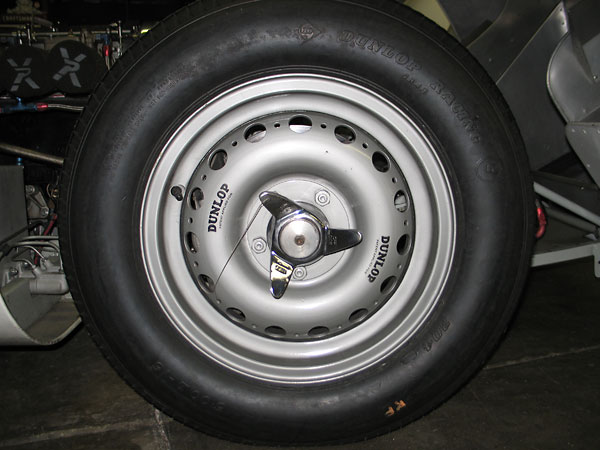
�
Dunlop steel wheels (Jaguar D-Type pattern).
�

�
Dunlop Racing tires (6.00L16).
�
Rear Suspension
�| Notes: | |||||||
| (1) | �
Before Brian Lister retired from racing, he made one final Costin-bodied, Jaguar-powered �
racecar. This was an experimental car with a space frame chassis designed by Frank Costin, �
instead of a twin tube chassis like all other Listers. The design of the space frame was �
fundamentally compromised because of the initial requirements that it (a) must fit under �
a stock Costin-Lister body, and (b) must accept the stock Costin-Lister suspension. �
Barely completed at the time of Brian Lister's retirement, the space-frame car was turned �
over to Syd Diggory who tuned and raced it. It proved substantially stiffer, somewhat �
lighter, and of course faster than the twin-tube cars. It won out of the box at Brands �
Hatch in 1960 while setting a new short circuit record, lapping in just 57.4 seconds, �
and finishing the race 26 seconds before John Bekaert's twin-tube Lister-Jaguar. The �
initial groundrule that a standard body should fit the new space-frame proved a little �
ironic: the car's third owner hired Frank Costin to develop a special, one-off coupe �
body for it. With the coupe body installed, it raced at LeMans in 1963 and 1964.�
� | ||||||
�
�
The two drawings featured above are based on original illustrations by James A. Allington�
for the book "Racing and Sports Car Chassis Design" by Michael Costin (Frank's brother) �
and David Phipps, copyright 1961. The drawings have been substantially re-created with �
additional and different features by Curtis Jacobson. Copyright 2010. All rights reserved. �
�
All photos shown here are from September 2009 when we viewed the car at The US Vintage Grand �
Prix at Watkins Glen. All photos by Curtis Jacobson and Don Moyer for BritishRaceCar.com, �
copyright 2010. All rights reserved.
�
| If you liked this article, you'll probably also enjoy these: | �|||||
 | �
Tivvy Shenton 1955 XK140 FHC | �
 | �
Jeff Snook 1956 XI LeMans | �
 | �
Tom Grudovich 1960 Sports Mk.1 | �
| You're invited to discuss anything you've seen here on The British Racecar Motorsports Forum! | �|||||
�
Notice: all the articles and almost all the photos on BritishRacecar.com are by Curtis Jacobson.
�
(Photos that aren't by Curtis are explicitly credited.) Reproduction without prior written permission is prohibited.
�
Contact us to purchase images or reproduction permission. Higher resolution images are optionally available.
�

 �
�